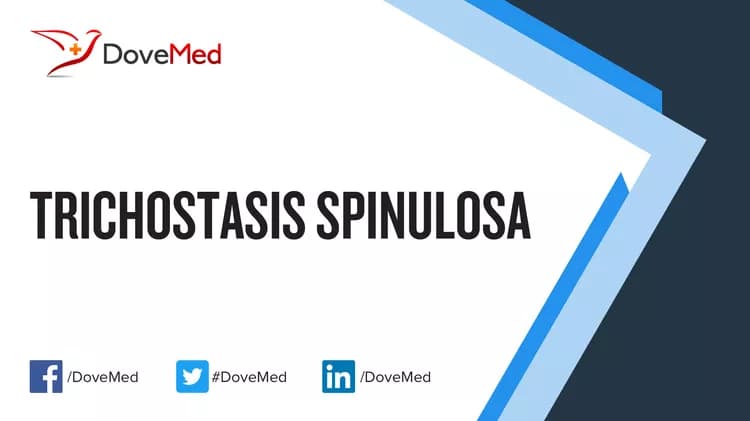What are the other Names for this Condition? (Also known as/Synonyms)
- Elevated Dark Spiny Papules on the Face or Trunk
- TS (Trichostasis Spinulosa)
What is Trichostasis Spinulosa? (Definition/Background Information)
- Trichostasis Spinulosa (TS) is an unusual hair follicle condition in which several hair strands are seen to arise from a single hair follicle. The condition may be confused with blackheads. TS is generally noted on the nose, but can occur on other parts of the face or body
- The cause of Trichostasis Spinulosa is not clearly understood. However, apart from cosmetic issues in some cases, the condition is not known to present any significant symptoms or complications
Who gets Trichostasis Spinulosa? (Age and Sex Distribution)
- Trichostasis Spinulosa typically occurs in older adults; the condition is rare in children
- Both males and females may be affected
- Worldwide, individuals of all racial and ethnic groups may be affected
What are the Risk Factors for Trichostasis Spinulosa? (Predisposing Factors)
- Currently, no risk factors have been clearly identified for Trichostasis Spinulosa
It is important to note that having a risk factor does not mean that one will get the condition. A risk factor increases one’s chances of getting a condition compared to an individual without the risk factors. Some risk factors are more important than others.
Also, not having a risk factor does not mean that an individual will not get the condition. It is always important to discuss the effect of risk factors with your healthcare provider.
What are the Causes of Trichostasis Spinulosa? (Etiology)
Currently, the exact cause of formation of Trichostasis Spinulosa is not well understood.
What are the Signs and Symptoms of Trichostasis Spinulosa?
The signs and symptoms of Trichostasis Spinulosa may include:
- Dark spiny papules on the face (commonly on the nose), chest, and back
- These may even appear on the scalp
- The papules contain very short hair tufts
- Appearance of the papules is superficially similar to blackheads
- No other significant symptoms or noted
How is Trichostasis Spinulosa Diagnosed?
Trichostasis Spinulosa is diagnosed on the basis of the following information:
- Physical examination of the individual and medical history evaluation
- Dermoscopy: Dermoscopy is a diagnostic tool where a dermatologist examines the skin using a special magnified lens
- Wood’s lamp examination: In this procedure, the healthcare provider examines the skin using ultraviolet light. It is performed to examine the change in skin pigmentation
- Skin biopsy, if necessary: A skin biopsy is performed and sent to a laboratory for a pathological examination. The pathologist examines the biopsy under a microscope. After putting together clinical findings, special studies on tissues (if needed) and with microscope findings, the pathologist arrives at a definitive diagnosis
A differential diagnosis may be necessary to eliminate other conditions that present similar signs and symptoms. This may include:
- Eruptive vellus hair cysts
- Keratosis pilaris
Many clinical conditions may have similar signs and symptoms. Your healthcare provider may perform additional tests to rule out other clinical conditions to arrive at a definitive diagnosis.
What are the possible Complications of Trichostasis Spinulosa?
The complications of Trichostasis Spinulosa may include:
- Emotional stress
- Cosmetic issues
- Low self-esteem if many papules are present on face (that may appear like blackheads)
Complications may occur with or without treatment, and in some cases, due to treatment also.
How is Trichostasis Spinulosa Treated?
Typically, no treatment is necessary for Trichostasis Spinulosa. However, if affected individuals require the papules removed for cosmetic reasons, it may be achieved by healthcare providers using methods such as:
- Using tweezers for pulling the papules out
- Squeezing papules out with the use of comedo extractor
- Depilatory wax treatment
- Laser depilation
Application of topical retinoids may be useful in minimizing future occurrences of papules, as well as in improving the appearance of the skin.
How can Trichostasis Spinulosa be Prevented?
- At the present time, the cause or risk factors for Trichostasis Spinulosa are not known, and therefore, no preventive methods or guidelines are available
- Once lesions appear, topical retinoids may be useful in minimizing the occurrence of additional papules
What is the Prognosis of Trichostasis Spinulosa? (Outcomes/Resolutions)
The prognosis of Trichostasis Spinulosa is generally good, as the condition is not known to present any significant signs and symptoms or complications.
Additional and Relevant Useful Information for Trichostasis Spinulosa:
The following DoveMed website link is a useful resource for additional information:
Related Articles
Test Your Knowledge
Asked by users
Related Centers
Related Specialties
Related Physicians
Related Procedures
Related Resources
Join DoveHubs
and connect with fellow professionals



0 Comments
Please log in to post a comment.